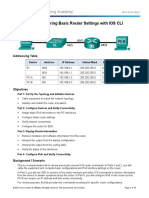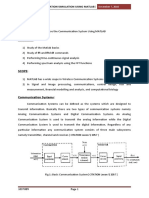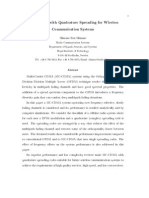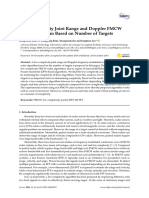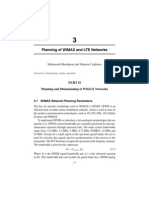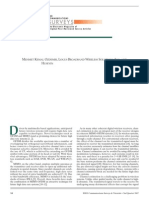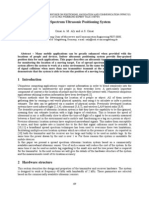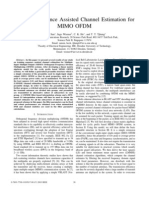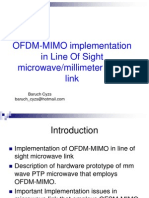A Wideband Digital Beamforming Method Based On Stretch Processing
A Wideband Digital Beamforming Method Based On Stretch Processing
Uploaded by
sukanya_13Copyright:
Available Formats
A Wideband Digital Beamforming Method Based On Stretch Processing
A Wideband Digital Beamforming Method Based On Stretch Processing
Uploaded by
sukanya_13Original Title
Copyright
Available Formats
Share this document
Did you find this document useful?
Is this content inappropriate?
Copyright:
Available Formats
A Wideband Digital Beamforming Method Based On Stretch Processing
A Wideband Digital Beamforming Method Based On Stretch Processing
Uploaded by
sukanya_13Copyright:
Available Formats
A Wideband digital Beamforming Method Based on Stretch Processing
HUIYONG LI, XUHONG ZHANG, ZISHU HE, JIA YU
College of Electronic Engineering
University of Electronic Science and Technology of China
Road JianShe, Chengdu, 610054
PR. China
E-mail:hyli@uestc.edu.cn
Abstract: - The calculation of wideband digital beamforming using traditonal methods is so large that it is hard
to realize in project. This paper describes a wideband digital beamforming method on the base of stretch
processing for linear frequency modulated (LFM) waveforms. This method offers advantages that are moderate
data rate for wideband signal processing by reducing the signal bandwidth greatly. In addition, the method not
only can get high range resolution of wideband array radar, but also can form good shape pattern with null at
interference, as the simulation results show. To the most important, this method compared to traditional
methods is easier for engineering implementation greatly.
Key-Words: Digital beamforming (DBF), linear frequency modulated (LFM), Stretch Processing , wideband,
Digital array radar
1 Introduction
Digital array radar is new phased array radar,
uses digital beamforming technology in transmitting
and receiving. It has a very good application prospect,
with digital, modular, scalable, and other excellent
features. For the need of enhancing anti-interference
ability, improving identification, recognition of the
target, and solving the problem of radar imaging,
radars transmit wideband signals for high-resolution.
Wideband digital array radar (WDAR) is digital
array radar using wideband waveforms, combines the
advantages of wideband signals and digital array
radar. In the recent years, WDAR attracts more and
more attention, becomes an important development
direction of the radar. And wideband digital
beamforming technology is one of the key
technologies on wideband digital array radar
[1]
.
The purpose of digital beamforming is to
suppress interference and to retain desired signal, so
that the signal, interference and noise ratio (SINR) of
the array output reaches the maximum. Early digital
beamforming is for narrowband signals, however,
narrowband digital beamformer cant solve the
problem of wideband digital beamforming.
Wideband signals can be seen as some narrowband
signals being superposed in frequency field, but it
doesnt mean that wideband array model equal to the
sum of these narrowband array models, and wide
band array processing is more complex.
At present, wideband signal algorithms can be
divided into two categories
[1][2]
. One is based on the
adaptive array structure of wideband signal
processing which is proposed by Frost
[3]
, called
space-time processing approach. This method is
complex for hardware implementation, and
computation is large. The other one is called
frequency-domain approach. It transforms wideband
signals into multi-way signals in different frequency
bands by FFT, and then does digital beamforming in
each frequency respectively. This method requires
high-speed digital devices for FFT.
WSEAS TRANSACTIONS on SIGNAL PROCESSING Huiyong Li, Xuhong Zhang, Zishu He, Jia Yu
ISSN: 1790-5052 251 Issue 7, Volume 5, July 2009
The wideband digital beamforming methods
mentioned above can be applied to any forms of
wideband signals, but are complex in computing and
hard for project implementation. In some
applications, the required processing rates will
exceed the current state of digital devices greatly,
especially when the waveform bandwidth is very
large.
On the radar, the main purpose of using
wideband signals is high-resolution, sometimes do
not need deal in the whole course, and the signal
form is known and identified usually, such as LFM
signal
[4]
. Linear frequency modulated(LFM) signal
has large time-bandwidth product 1 TB , can
solve the contradiction between the range and
distance resolution better, applicable to long-range,
ultra long-range surveillance radar.
f
0
f
0
t
T
{
B
Figure.1 Linear frequency modulated signal
For a LFM signal, the relationship between
instantaneous frequency and time can be described as
figure 1. Its carrier frequency changes in linear from
initial frequency to end frequency, and can be written
as
0
( ) 2 2 ( / 2 / 2) f t f t T t T = + < < . There,
0
f
is the pulse center frequency, / B T = is
frequency modulation slope, B is bandwidth, T is
the pulse duration.
The paper describes a wideband digital
beamforming method, which uses the special
properties of LFM waveforms. The method does not
require doing FFT to the received data, so that it does
not need high speed A/D converters and digital
processors. When radars transmit LFM signal as
wideband pulse, the target signal bandwidth can be
reduced greatly through stretch processing and
narrow-band filtering. Then beamforming can be
finished in a small bandwidth, the data sampling rate
reduced greatly, in favor of the project to achieve.
In this paper, section 2 introduces the basic
theory of stretch processing. Section 3 improves
stretch processing to carry out beamforming
flexibility, and researches interference nulling
technology based on stretch processing at subarray
level in section 4 followed. A summary is given in
Section 5.
2 Stretch Processing
The basic idea of stretch processing is that two
LFM signals having the same frequency modulation
slope are mixed together and filtered, the output will
be a narrowband sinusoidal signal. The frequency of
the sinusoidal signal is proportional to the time-offset
between the two LFM signals. Therefore, a high
range resolution can be achieved by analyzing the
frequency component. By the way, the time-offset is
determined by the difference between actual distance
and estimated distance of the target. If the target is
multi-point, the output of mixer is a group of
narrow-band sinusoidal signals.
Figure.2 shows stretch processing block
diagram for a single channel. After transmitting a
wideband LFM pulse ( ) x t , radar will receive a
delayed version of the transmitted pulse
0
( ) x t t
as the target echo, and
0
t is unknown two-way
propagation delay determined by the targets range .
At the same time, the transmitted signal was delayed
to the estimated target range as the deramping
oscillator
'
0
( ) x t t . The echo is demodulated in the
mixer using the local oscillation signal. The
following lowpass filter converts the target range
difference into frequency difference, and the
bandwidth of the filter limits the range region. Then,
the information of the target can be obtained by
taking FFT.
WSEAS TRANSACTIONS on SIGNAL PROCESSING Huiyong Li, Xuhong Zhang, Zishu He, Jia Yu
ISSN: 1790-5052 252 Issue 7, Volume 5, July 2009
'
0
( ) x t t
0
( ) x t t
rec
T
f
0
f
'
0
t
T
f
0
f
0
t
T
f
t
t t
'
0 0
( ) t t
Amp
'
0 0
( ) t t
f
Figure.2 stretch processing block diagram
Single-channel stretch processor is described
above. For a array radar, a channel or a subarray can
be seen as a channel, and each receiver is a stretch
processor for multi-channel stretch processing,
shown in figure.3.
reference signal
( ')
r k
x t t
echo
( )
k
x t t
2,k
x
3,k
x
4,k
x
( ) y t
Figure.3 stretch processor for the kth channel
If every channel transmits the same LFM signal
which is expressed as
2
0
( ) cos(2 ( 0.5 ))
/ 2 / 2
x t f t t
T t T
= +
< <
(1)
The echo of the kth channel ( )
k
x t t is
( )
( ) ( )
( ) ( )
1,
2
0
-
-
cos 2 - 0.5 -
k k
k
k k
x x t t a
t t
f t t t t rect
T
= =
| |
+
|
\
(2)
There,
k r k
t = + is the delay of the echo.
2 /
r
R c = is the two-way propagation delay time,
and R is the fact range of the target.
k
is
determined by channel space d and direction of the
target , can be obtained by ( 1) sin
k
k d =
previously. Besides, a is the attenuation factor
dependent upon transmission distance, the target
RCS, antenna gain, etc. Assume 1 a = .
The reference signal in the kth channel is
( ) ( ) ( )
( ) ( )
'
2
' ' '
0, 0
cos 2 0.5
k
k k k k
r
t t
x x t t f t t t t rect
T
| |
= = +
|
\
(3)
'
k
t is the delay of the reference signal, and
r
T T >
generally.
The output of the lowpass filter is the signal has
WSEAS TRANSACTIONS on SIGNAL PROCESSING Huiyong Li, Xuhong Zhang, Zishu He, Jia Yu
ISSN: 1790-5052 253 Issue 7, Volume 5, July 2009
been stretch processed, and can be described as
follow after digitalization.
( ) ( ) ( )
' 2 ' 2 '
0
2 0.5 2
4,
'
1
( )
2
-
k k k k k k
j f t t t t j t t t
k
k k
r
x t e e
t t t t
rect rect
T T
(
+
=
| | | |
| |
\
\
(4)
At this point, the frequency and phase of the kth
channel output respectively are
( )
'
k k k
f t t =
and
( ) ( )
' 2 ' 2
0
2 [ 0.5 ]
k k k k k
f t t t t = + , and both
of them are related to k . The frequency and phase
of the signal in different channel are inconsistent;
this is what we do not want.
In order to avoid the above-mentioned
inconsistencies of frequency and phase, two groups
delay are introduced. One is delay for the reference
signal, the other one is digital delay filter after
digitalization.
Firstly, we rewrite the kth channel delay of the
reference as ' '
k r k
t = + , '
r
is inexact target
range, can be measured previously. Then,
k
can
be delayed using the digital FIR filter whose impulse
response is ( ) ( )
k k
h t t = + . The output of the kth
channel after the two groups of delay is
( ) ( ) ( )
' 2 ' 2 '
0
2 0.5 2
'
1
( )
2
- -
r r r r r r
j f j t
r r
r
y t e e
t t
rect rect
T T
(
+
=
| |
| |
| |
\
\
(5)
Now, frequency and phase are the same between
different channels, and range information of the
target can be obtained by
'
2
r
c f
R
| |
=
|
\
(6)
where f denotes to the frequency of the output
signal.
Here we illustrate the high range resolution of
using stretch processing for wideband signals. In this
example, a array of 16 channels is considered. The
channel space d is half of the wavelength
corresponding with the highest frequency of the
transmitted signal. The echo is a 200 MHz LFM
pulse of L-band, with the pulse duration 20 s , and
SNR is 0 dB. If the direction of the single-point
target is
0
20 ,and the range is 1101 km. The
estimated range by a narrowband pulse is 1100 km,
and set range region 5km. Beside, the noise of the
receiver is Gaussian white noise with zero mean and
variance of 1. A peak is formed at the 1101 km in the
range region in figure.4, it means that the range
estimated by this array radar is 1101 km, with the
error of 0 km. Compared with the narrowband radar;
this radar can extract the distance information to the
target accurately. Because the bandwidth of this radar
is 200 MHz, its range resolution can be calculated by
/ 2 0.75 R c B m = = , then the largest range estimation
error is 0.75m, it is so little.
1.0975 1.098 1.0985 1.099 1.0995 1.1 1.1005 1.101 1.1015 1.102 1.1025
x 10
6
-45
-40
-35
-30
-25
-20
-15
-10
-5
0
X: 1.101e+006
Y: 0
range m
s
p
e
c
t
r
u
m
(
d
B
)
Figure.4 estimated range of single-point target
Assume the range resolution of the narrowband
radar used for estimating range is 150m, its time
resolution is 1/ 1 B s = . For the wideband radar
whose time-bandwidth product is 4000 in this
example, the frequency of the signal after stretch
processing is 10 MHz, the sampling rate is required
just for 20 MHz, reduced greatly.
WSEAS TRANSACTIONS on SIGNAL PROCESSING Huiyong Li, Xuhong Zhang, Zishu He, Jia Yu
ISSN: 1790-5052 254 Issue 7, Volume 5, July 2009
3 Proposed Flexible beamforming
method
From the analysis above, we can see that the
signals after stretch processing can not taking
flexible beamforming, because of the array delay
time for reference signal. It is the shortcomings of
stretch processing. In the figure.3, we reconstruct
reference signal as ( ')
r
x t without
k
, and the
echo is still shown as the formula of (2). After
mixing, lowpass filtering and digitalization, the
output can be written as
( ) ( ) ( )
' ' 2 ' 2
0
2
0
2 2
4,
- 2 - 2 2
'
1
( )
2
-
r r r r r r
k k k r k
j t j f j
k
j t j f j j
r k r
r
x t e e e
e e e e
t t
rect rect
T T
=
| | | |
| |
\
\
(7)
The last four terms of the formula are related to
k
,that is, the direction of the target.
4,1
( ) x t
4,
( )
k
x t
M
( )
k
y t
1
( ) y t
1
( ) z t
1
( )
k
z t
k
M
Figure.5 beamforming module
As shown in figure.5, While taking beam-
forming, if the scanning angular is , let
( 1) sin /
k
k d c
=
2
0
2 2 - - 2
( )
k k k k
j t j f j j
k
y t e e e e
= , we can
describe ( )
k
z t as
( ) ( ) ( )
( ) ( ) ( )
( )
' ' 2 ' 2
0
2 2
0
'
4,
2 [2 ]
2 2
'
2
( ) ( ) ( )
1
2
-
r r r r r r
k k
k k k k
r k r k
k k k
j t j f
j
j t j f
j
r k r
r
z t x t y t
e e
e e e
t t
e rect rect
T T
=
=
| | | |
| |
\
\
(8)
( )
k
y t here can be understood as scanning vector. It
is different from that of Single-frequency signal
because of the difference of the signal form.
Now, the realization of the array delay requires
delaying ( )
k
z t by
k
, that is
( ) ( ) ( )
( ) ( ) ( )
( ) ( ) ( )
' ' 2 ' 2
0
2 2
0
' '
2 2
2 2
2 2
2
'
1
( )
2
-
r r r r r r
k k
k k k k
r k r k r r k
k k k
j t j f j
k k
j
j t j f
j j
j
r k k r k
r
z t e e e
e e e
e e e
t t
rect rect
T T
+ =
| | + + | |
| |
\
\
(9)
If = , that is
k k
=
( ) ( ) ( )
' ' 2 ' 2
0
2 2
'
1
( )
2
-
r r r r r r
j t j f j
k k
r k r
r
z t e e e
t t
rect rect
T T
+ =
| | +
| |
| |
\
\
(10)
( )
k k
z t + is unrelated to k, so that the
receiving signal of every channel can sum up in the
same phase, and get the top power. In addition, the
frequency of (10) is
( )
'
k r r
f = , are the same
between any two different channels, so the range can
be obtained by analyzing the frequency.
Using the proposed method to the example, the
result is shown in figure 6. Figure 6 has a peak at
1101 km. We can get the conclusion that the range of
WSEAS TRANSACTIONS on SIGNAL PROCESSING Huiyong Li, Xuhong Zhang, Zishu He, Jia Yu
ISSN: 1790-5052 255 Issue 7, Volume 5, July 2009
the target is 1101 km.
1.0975 1.098 1.0985 1.099 1.0995 1.1 1.1005 1.101 1.1015 1.102 1.1025
x 10
6
-50
-45
-40
-35
-30
-25
-20
-15
-10
-5
0
range m
s
p
e
c
t
r
u
m
(
d
B
)
Figure.6 range estimation
If the first channel is seen as the reference
channel, and its corresponding target range is seen as
the reference range, the delay in the formula derived
in this section has nothing to do with the target range.
That is,
( ) ( ) ( )
( )
2 2
0
2 2
2
1
( )
2
k k
k k k k
k k k
j
j t j f
k k
j
k k k
r
z t e e e
t t
e rect rect
T T
+ =
| | + + | |
| |
\
\
(11)
If = , that is
k k
=
1
( )
2
k
k k
r
t t
z t rect rect
T T
| | +
| |
+ =
| |
\
\
(12)
The frequency of each channel is zero; the range
obtained by analyzing frequency is the reference
range corresponding to the reference channel.
-80 -60 -40 -20 0 20 40 60 80
-90
-80
-70
-60
-50
-40
-30
-20
-10
0
angular
s
p
e
c
t
r
u
m
d
B
(a) Pattern
-2500 -2000 -1500 -1000 -500 0 500 1000 1500 2000 2500
-45
-40
-35
-30
-25
-20
-15
-10
-5
0
range m
s
p
e
c
t
r
u
m
(
d
B
)
(b) Range information
Figure.7 Wideband digital beamforming
The pattern in Figure.7(a) has a good shape and
forms a mainlobe at
0
20 which is the direction of
the required signal, so that this radar can receive
LFM signals from
0
20 better. It is just
beamforming, the range information is 0.
In the discussion followed, the first channel is
always seen as the reference channel, and its
corresponding target range is seen as the reference
range.
4 Wideband beamforming method
based on stretch processing
When there is wideband interference, stretch
processing and filter can reduce interference power
to some extent. Even if interference power is not too
high, one-dimensional range image can be obtained.
However, it doesnt work when interference power is
very strong, and the echo is still submerged in
interference. In order to obtain greater signal
interference and noise rate of output, and improve
the detection and identification of the weak echo,
null is needed at the interference.
Speaking on theory, beamforming method based
on stretch processing can form mainlobe at the
required direction, and the weight in the
single-frequency can form null at the interference,
then the combination of the two can nulling the
WSEAS TRANSACTIONS on SIGNAL PROCESSING Huiyong Li, Xuhong Zhang, Zishu He, Jia Yu
ISSN: 1790-5052 256 Issue 7, Volume 5, July 2009
interference.
Assumed that the direction of target is , and
one interference comes from , the following
nulling method is after stretch processing and
narrowband filtering. Consider a M-channel uniform
linear array(ULA), the delay of the signal of the kth
channel relative to that of the reference channel is
( 1) sin /
k
k d c = (13)
where c denotes the velocity of light.
To make the phase of every channel signals
after stretch processing and narrowband filtering
consistent, the weight of kth channel for phase
compensation can be described as
2
0
2 2 ( 0.5 )
,
( )
k k k
j t j f
c k
w t e e
= (14)
The delay of the interference which comes from
of the kth channel relative to that of the reference
channel is
,
( 1) sin /
k
k d c
= (15)
When the transmitting signals frequency is
0
f ,
The single-frequency weight
n
w can form mainlobe
at the target direction, and null at the interference
direction. It can be generated by conventional
narrowband method, such as MVDR.
n
w satisfies
1
k k
k
w a
=
, and
0
2
k
j f
k
a e
= .
To enhance the algorithm robustness, wide
notch formation technology is introduced, which is
implemented by a simple modification of the
covariance matrix.
= R A R
%
o (16)
In the formula (16), the modification is achieved
by a matrix A, the covariance matrix modified can
be calculated as the Hadamard product of A and
R. The element of A is a sinc function
[5][10]
, with
the notch width factor. Here we write the new
single-frequency weight as
k
w .
If the weight for beamforming is
, ,
( ) ( )
o k c k k k
w t w t w a
= (17)
That mainlobe can be formed at , but can not form
nullat . Thus, compensation factor is needed, and
can be described as
2 2
, ,
2 ( ) ( )
( )
k k k k
j t j
k
q t e e
= (18)
As a result, the weight after compensation is
, ,
( ) ( ) ( ) ( ) ( )
k k o k k c k k k
W t q t w t q t w t w a
= = (19)
If interference is a LFM signal in the direction
of
0
40 , and has the same center frequency and
bandwidth, taking wideband beamforming in (19).
Figure.8(b) shows that notch is formed in the pattern
by using the weight in (19), the same as that using
single-frequency weight
k
w in figure.8(a), so that
interference can be suppressed well. The range
information illustrates the reference range
corresponding to the reference channel is 0.
-80 -60 -40 -20 0 20 40 60 80
-120
-100
-80
-60
-40
-20
0
angular
s
p
e
c
t
r
u
m
d
B
(a) Pattern using narrowband weight
-80 -60 -40 -20 0 20 40 60 80
-120
-100
-80
-60
-40
-20
0
angular
s
p
e
c
t
r
u
m
d
B
(b) Pattern using this section method
WSEAS TRANSACTIONS on SIGNAL PROCESSING Huiyong Li, Xuhong Zhang, Zishu He, Jia Yu
ISSN: 1790-5052 257 Issue 7, Volume 5, July 2009
-300 -200 -100 0 100 200 300
-35
-30
-25
-20
-15
-10
-5
0
range m
s
p
e
c
t
r
u
m
(
d
B
)
(c) Range information
Figure.8 Wideband digital beamforming with null
If the array is divided into L adjacent uniform
subarrays, N is the number of elements in each
subarray, that is, M L N = . Figure 9 is the block
diagram for beamforming based on stretch
processing at subarray level. Phase compensation is
carried out to the element in the subarray, and weight
for nulling is for the subarray.
_1
( )
sub
w t
_
( )
sub N
w t
1
( ) w t
_1
( )
sub
w t
_
( )
sub N
w t
( )
L
w t
M M M M
M
M
Figure.9 Wideband digital beamforming based on stretch processing at subarray level
Assumed that the first element in every subarray
is the reference element, and the first subarray is the
reference subarray for the array. The delay of the
signal of the nth element relative to that of the
reference element is
( 1) sin / 1, ,
n
n d c n N = = L (20)
And the delay of the signal of the lth subarray
relative to that of the reference subarray is
( 1) sin /
1, ,
l
l Nd c
l L
=
= L
(21)
Then, the receiving signal of the nth element in the
lth subarray is
2
0
2 2
0 0
2
0
,
2 [ ( ) 0.5 ( ) ]
2 ( 0.5 ) 2 ( 0.5 )
2 ( 0.5 ) 2
( ) ( ( ))
e
n l n l
n n n
l l l n l
l n n l
j f t t
j f t t j t f
j t f j
x t x t
e e
e e
+
+ +
+
= +
=
=
(22)
Taking stretch processing to the signal of (22),
obtains
2 2
0 0
2 ( 0.5 ) 2 ( 0.5 ) 2
( )
n n n l l l n l
j t f j t f j
n
x t e e e
+ +
=
(23)
If the cross-term
2
n l
j
e
is neglected, the
phase compensation weight of the nth in each
WSEAS TRANSACTIONS on SIGNAL PROCESSING Huiyong Li, Xuhong Zhang, Zishu He, Jia Yu
ISSN: 1790-5052 258 Issue 7, Volume 5, July 2009
subarray
_
( )
sub n
w t can be described as
2
0
2 2 ( 0.5 )
_ ,
( ) ( )
n n n
j t j f
sub n c n
w t w t e e
= = (24)
As shown in section 3, the scanning vector of
nth element in every subarray can be written as
2
0
2 ( ) 2 [ ( ) 0.5 ( ) ]
( , )
n n n
j t j f
n
y t e e
= , and
( ) ( 1) sin /
n
n d c = ,denotes to the delay of the
nth element related to that of the reference element
when the scanning angular is .
Because the array is divided uniformly and
adjacently, subarrays have the same output
,
1
_ ( , ) ( ) ( , )
N
c n n
n
z sub t w t y t
=
=
(25)
Interference nulling realized by digital weight at
the subarray level. For the interference coming from
, the delay of the lth subarray related to that of the
reference subarray is
,
sin /
l
lNd c
= (26)
Then the compensation factor in (18) can be
rewritten as
2 2
, ,
2 ( ) ( )
( )
l l l l
j t j
l
q t e e
= (27)
The weight at subarray can be described as
( ) ( ) ( )
l l l l l
w t q t w t wa
= (28)
Where,
0
2
, ( 1) sin /
l
j f
l l
a e l Nd c
= = .
Divided 40 channel ULA array into 8 subarrays
uniformly, the pattern of subarrays are the same,
shown in figure 10(a).It is statistic pattern because
the weight in subarray is only for phase
compensation. Figure 10(b) is the array pattern with
nulling, notch is formed in the direction of
0
40 ,
however, the mainlobe of the pattern has been offset,
which is due to the unwanted null.
-80 -60 -40 -20 0 20 40 60 80
-25
-20
-15
-10
-5
0
angular
s
p
e
c
t
r
u
m
d
B
(a) Pattern of subarrays
-80 -60 -40 -20 0 20 40 60 80
-120
-100
-80
-60
-40
-20
0
angular
s
p
e
c
t
r
u
m
d
B
(b) Pattern with null
Figure.10 wideband digital beamforming at subarray
level
5 Conclusion
In order to reduce the computation of wideband
signal digital processing, a wideband digital
beamforming method based on stretch processing is
present in this paper. The bandwidth of target signal
after stretch processing and narrowband filtering, the
data sample ratio is reduced greatly, so that
beamforming can be carried out in a small bandwidth
and the method is easy for engineering
complementation. Simulation results demonstrated
that the method proposed on the base of stretch
processing can realize wideband interference nulling,
achieve beamforming performance.
Reference:
[1] Longyang Huang, Bin Shen, An efficient
subband method for wideband adaptive
beamforming, Advanced communication
WSEAS TRANSACTIONS on SIGNAL PROCESSING Huiyong Li, Xuhong Zhang, Zishu He, Jia Yu
ISSN: 1790-5052 259 Issue 7, Volume 5, July 2009
technology, Feb. 2008, Vol.3 :1489-1492
[2] Tuan-Do-Hong, P. Russer, Signal processing
for wideband smart antenna array applications,
IEEE Microwave Magazine, Vol.5, No.1, Mar.
2004:57-67
[3] Frost III O L, An algorithm for linearly
constrained adaptive array processing, Proc.
IEEE, Aug. 1972, 60(8):926-935
[4] C. Tarran, M. Mitchell, Wideband phased array
radar with digital adaptive beamforming, High
resolution radar and sonar, May.1999,1-7
[5] J. Rabideau, Improved wideband time delay
beam-steering, Proc. 35th Asilmar Conf.
Signals, Syst. Computers,2001,1385-1390
[6] Schikorr. M, High range resolution with digital
processing, Radar Conf. 2008.IEEE. 26-30
May 2008:1-6
[7] Cao Yun-he, Zhang Shou-hong, and Luo
Yong-jian, etc, Beamforming techniques of
wideband and large scan angle based on stretch
processing, Journal of Xian Jiaotong
University, 200438(8):847-850
[8] R. J. Mailloux,Covariance matrix augmentation
to produce adaptive array pattern troughs.,
Electron. Lett. 1995, vol.3(10):771772
[9] M. Zatman, Production of adaptive array
troughs by dispersion synthesis, Electron. Lett.
1995, vol. 31(25):21412142
[10] R. Guerci, Theory and application of
covariance matrix tapers for robust adaptive
beamforming, IEEE Trans on SP199947(4)
977985
WSEAS TRANSACTIONS on SIGNAL PROCESSING Huiyong Li, Xuhong Zhang, Zishu He, Jia Yu
ISSN: 1790-5052 260 Issue 7, Volume 5, July 2009
You might also like
- 2-A Comparative Study of Time-Delay Estimation Techniques UsingNo ratings yet2-A Comparative Study of Time-Delay Estimation Techniques Using57 pages
- Leung - VLSI For Wireless Communication 2e - Solutions ManualNo ratings yetLeung - VLSI For Wireless Communication 2e - Solutions Manual122 pages
- 4.1.4.6 Lab - Configuring Basic Router Settings With IOS CLI100% (1)4.1.4.6 Lab - Configuring Basic Router Settings With IOS CLI10 pages
- Measurement and Evaluation of RFID Transmission Characteristic For Long Range SystemsNo ratings yetMeasurement and Evaluation of RFID Transmission Characteristic For Long Range Systems4 pages
- AIM Objective: Digital Communication Simulation Using MatlabNo ratings yetAIM Objective: Digital Communication Simulation Using Matlab18 pages
- GFDM - Generalized Frequency Division Multiplexing: Gerhard Fettweis, Marco Krondorf and Steffen BittnerNo ratings yetGFDM - Generalized Frequency Division Multiplexing: Gerhard Fettweis, Marco Krondorf and Steffen Bittner4 pages
- A Comparative Analysis of LS and MMSE Channel Estimation Techniques For MIMO-OFDM SystemNo ratings yetA Comparative Analysis of LS and MMSE Channel Estimation Techniques For MIMO-OFDM System6 pages
- Overspread Digital Transmission Over Wireless Linear Time-Varying MIMO SystemsNo ratings yetOverspread Digital Transmission Over Wireless Linear Time-Varying MIMO Systems13 pages
- Application of Digital signal processing in radarNo ratings yetApplication of Digital signal processing in radar6 pages
- MC-CDMA With Quadrature Spreading For Wireless Communication SystemsNo ratings yetMC-CDMA With Quadrature Spreading For Wireless Communication Systems25 pages
- Performance and Analysis of OFDM Signal Using Matlab SimulinkNo ratings yetPerformance and Analysis of OFDM Signal Using Matlab Simulink7 pages
- 3-Low-Complexity Joint Range and Doppler FMCW Radar Algorithm Based On Number of TargetsNo ratings yet3-Low-Complexity Joint Range and Doppler FMCW Radar Algorithm Based On Number of Targets14 pages
- Planning and Dimensioning of Wimax NetworksNo ratings yetPlanning and Dimensioning of Wimax Networks37 pages
- Spread Spectrum and Pseudonoise SequencesNo ratings yetSpread Spectrum and Pseudonoise Sequences6 pages
- Spread Spectrum Ultrasonic Positioning SystemNo ratings yetSpread Spectrum Ultrasonic Positioning System6 pages
- Behaviour of OFDM System Using MATLAB SimulationNo ratings yetBehaviour of OFDM System Using MATLAB Simulation5 pages
- Linear Frequency Modulation Pulse Compression Technique On Generic Signal ModelNo ratings yetLinear Frequency Modulation Pulse Compression Technique On Generic Signal Model20 pages
- Adaptive Channel Estimation For Underwater Acoustic Mimo Ofdm SystemsNo ratings yetAdaptive Channel Estimation For Underwater Acoustic Mimo Ofdm Systems6 pages
- Spread Spectrum Communications Using Chirp SignalsNo ratings yetSpread Spectrum Communications Using Chirp Signals5 pages
- Signal Detection For 3GPP LTE Downlink: Algorithm and ImplementationNo ratings yetSignal Detection For 3GPP LTE Downlink: Algorithm and Implementation14 pages
- (1967) Digital Pulse Compression Radar ReceiverNo ratings yet(1967) Digital Pulse Compression Radar Receiver9 pages
- Spectral Correlation Based Signal Detection MethodNo ratings yetSpectral Correlation Based Signal Detection Method6 pages
- Wireless Communication Systems Module 4: Digital Modulation and Pulse Shaping TechniquesNo ratings yetWireless Communication Systems Module 4: Digital Modulation and Pulse Shaping Techniques9 pages
- Performance Analysis of MIMO-OFDM System Using QOSTBC Code Structure For M-QAMNo ratings yetPerformance Analysis of MIMO-OFDM System Using QOSTBC Code Structure For M-QAM12 pages
- Review of Multimode Techniques For Software Defined RadioNo ratings yetReview of Multimode Techniques For Software Defined Radio8 pages
- Performance Analysis of Phase Noise Impaired Ofdm Systeminamultipath Fading ChannelNo ratings yetPerformance Analysis of Phase Noise Impaired Ofdm Systeminamultipath Fading Channel6 pages
- A Novel Approach For Cognitive Radio Sensing Using Wideband Chirp SignalNo ratings yetA Novel Approach For Cognitive Radio Sensing Using Wideband Chirp Signal4 pages
- On Timing Offset and Frequency Offset Estimation in LTE UplinkNo ratings yetOn Timing Offset and Frequency Offset Estimation in LTE Uplink10 pages
- Training Sequence Assisted Channel Estimation For Mimo Ofdm: Sumei Sun, Ingo Wiemer, C. K. Ho, and T. T. TjhungNo ratings yetTraining Sequence Assisted Channel Estimation For Mimo Ofdm: Sumei Sun, Ingo Wiemer, C. K. Ho, and T. T. Tjhung6 pages
- Performance Analysis of A Trellis Coded Beamforming Scheme For MIMO Fading ChannelsNo ratings yetPerformance Analysis of A Trellis Coded Beamforming Scheme For MIMO Fading Channels4 pages
- Comparison of The Sensitivities of MC-CDMA and MC-DS-CDMA To Carrier Frequency OffsetNo ratings yetComparison of The Sensitivities of MC-CDMA and MC-DS-CDMA To Carrier Frequency Offset7 pages
- Intercept Receiver Signal Processing Techniques To DetectNo ratings yetIntercept Receiver Signal Processing Techniques To Detect3 pages
- OFDM-MIMO Implementation in Line of Sight Microwave/millimeter Wave LinkNo ratings yetOFDM-MIMO Implementation in Line of Sight Microwave/millimeter Wave Link52 pages
- Radio Frequency Identification and Sensors: From RFID to Chipless RFIDFrom EverandRadio Frequency Identification and Sensors: From RFID to Chipless RFIDNo ratings yet
- Non-Linearities in Passive RFID Systems: Third Harmonic Concept and ApplicationsFrom EverandNon-Linearities in Passive RFID Systems: Third Harmonic Concept and ApplicationsNo ratings yet
- Digital Signal Processing Techniques and Applications in Radar Image ProcessingFrom EverandDigital Signal Processing Techniques and Applications in Radar Image ProcessingNo ratings yet
- Active Harmonic Filter (AHF) : AHF Wallmount AHF Cabinet MountNo ratings yetActive Harmonic Filter (AHF) : AHF Wallmount AHF Cabinet Mount16 pages
- T2192-Technology and Innovation ManagementNo ratings yetT2192-Technology and Innovation Management3 pages
- EGVV65A-FL-C3-4XR - Product SpecificationNo ratings yetEGVV65A-FL-C3-4XR - Product Specification4 pages
- FAN73711 High-Current, High-Side Gate Drive IC: Features DescriptionNo ratings yetFAN73711 High-Current, High-Side Gate Drive IC: Features Description12 pages
- Assessment Method-Based Instructions and Guidelines: Skills TestNo ratings yetAssessment Method-Based Instructions and Guidelines: Skills Test20 pages
- CyberPolygon Transcript FINAL 11june2021No ratings yetCyberPolygon Transcript FINAL 11june202150 pages
- Pavement Pothole Detection and Severity Measurement Using Laser ImagingNo ratings yetPavement Pothole Detection and Severity Measurement Using Laser Imaging5 pages
- Altium Tutorial Version24March2014 FinalNo ratings yetAltium Tutorial Version24March2014 Final33 pages
- Solar Battery Charger With MPPT Using MicrocontrollerNo ratings yetSolar Battery Charger With MPPT Using Microcontroller28 pages
- AOS-CX Simulator Lab - Spanning Tree Basics Lab GuideNo ratings yetAOS-CX Simulator Lab - Spanning Tree Basics Lab Guide18 pages
- Drone Fleet Management System LLD DesignNo ratings yetDrone Fleet Management System LLD Design2 pages
- 2-A Comparative Study of Time-Delay Estimation Techniques Using2-A Comparative Study of Time-Delay Estimation Techniques Using
- Leung - VLSI For Wireless Communication 2e - Solutions ManualLeung - VLSI For Wireless Communication 2e - Solutions Manual
- 4.1.4.6 Lab - Configuring Basic Router Settings With IOS CLI4.1.4.6 Lab - Configuring Basic Router Settings With IOS CLI
- Measurement and Evaluation of RFID Transmission Characteristic For Long Range SystemsMeasurement and Evaluation of RFID Transmission Characteristic For Long Range Systems
- AIM Objective: Digital Communication Simulation Using MatlabAIM Objective: Digital Communication Simulation Using Matlab
- GFDM - Generalized Frequency Division Multiplexing: Gerhard Fettweis, Marco Krondorf and Steffen BittnerGFDM - Generalized Frequency Division Multiplexing: Gerhard Fettweis, Marco Krondorf and Steffen Bittner
- A Comparative Analysis of LS and MMSE Channel Estimation Techniques For MIMO-OFDM SystemA Comparative Analysis of LS and MMSE Channel Estimation Techniques For MIMO-OFDM System
- Overspread Digital Transmission Over Wireless Linear Time-Varying MIMO SystemsOverspread Digital Transmission Over Wireless Linear Time-Varying MIMO Systems
- MC-CDMA With Quadrature Spreading For Wireless Communication SystemsMC-CDMA With Quadrature Spreading For Wireless Communication Systems
- Performance and Analysis of OFDM Signal Using Matlab SimulinkPerformance and Analysis of OFDM Signal Using Matlab Simulink
- 3-Low-Complexity Joint Range and Doppler FMCW Radar Algorithm Based On Number of Targets3-Low-Complexity Joint Range and Doppler FMCW Radar Algorithm Based On Number of Targets
- Linear Frequency Modulation Pulse Compression Technique On Generic Signal ModelLinear Frequency Modulation Pulse Compression Technique On Generic Signal Model
- Adaptive Channel Estimation For Underwater Acoustic Mimo Ofdm SystemsAdaptive Channel Estimation For Underwater Acoustic Mimo Ofdm Systems
- Spread Spectrum Communications Using Chirp SignalsSpread Spectrum Communications Using Chirp Signals
- Signal Detection For 3GPP LTE Downlink: Algorithm and ImplementationSignal Detection For 3GPP LTE Downlink: Algorithm and Implementation
- Spectral Correlation Based Signal Detection MethodSpectral Correlation Based Signal Detection Method
- Wireless Communication Systems Module 4: Digital Modulation and Pulse Shaping TechniquesWireless Communication Systems Module 4: Digital Modulation and Pulse Shaping Techniques
- Performance Analysis of MIMO-OFDM System Using QOSTBC Code Structure For M-QAMPerformance Analysis of MIMO-OFDM System Using QOSTBC Code Structure For M-QAM
- Review of Multimode Techniques For Software Defined RadioReview of Multimode Techniques For Software Defined Radio
- Performance Analysis of Phase Noise Impaired Ofdm Systeminamultipath Fading ChannelPerformance Analysis of Phase Noise Impaired Ofdm Systeminamultipath Fading Channel
- A Novel Approach For Cognitive Radio Sensing Using Wideband Chirp SignalA Novel Approach For Cognitive Radio Sensing Using Wideband Chirp Signal
- On Timing Offset and Frequency Offset Estimation in LTE UplinkOn Timing Offset and Frequency Offset Estimation in LTE Uplink
- Training Sequence Assisted Channel Estimation For Mimo Ofdm: Sumei Sun, Ingo Wiemer, C. K. Ho, and T. T. TjhungTraining Sequence Assisted Channel Estimation For Mimo Ofdm: Sumei Sun, Ingo Wiemer, C. K. Ho, and T. T. Tjhung
- Performance Analysis of A Trellis Coded Beamforming Scheme For MIMO Fading ChannelsPerformance Analysis of A Trellis Coded Beamforming Scheme For MIMO Fading Channels
- Comparison of The Sensitivities of MC-CDMA and MC-DS-CDMA To Carrier Frequency OffsetComparison of The Sensitivities of MC-CDMA and MC-DS-CDMA To Carrier Frequency Offset
- Intercept Receiver Signal Processing Techniques To DetectIntercept Receiver Signal Processing Techniques To Detect
- OFDM-MIMO Implementation in Line of Sight Microwave/millimeter Wave LinkOFDM-MIMO Implementation in Line of Sight Microwave/millimeter Wave Link
- Radio Frequency Identification and Sensors: From RFID to Chipless RFIDFrom EverandRadio Frequency Identification and Sensors: From RFID to Chipless RFID
- Non-Linearities in Passive RFID Systems: Third Harmonic Concept and ApplicationsFrom EverandNon-Linearities in Passive RFID Systems: Third Harmonic Concept and Applications
- Digital Signal Processing Techniques and Applications in Radar Image ProcessingFrom EverandDigital Signal Processing Techniques and Applications in Radar Image Processing
- Active Harmonic Filter (AHF) : AHF Wallmount AHF Cabinet MountActive Harmonic Filter (AHF) : AHF Wallmount AHF Cabinet Mount
- FAN73711 High-Current, High-Side Gate Drive IC: Features DescriptionFAN73711 High-Current, High-Side Gate Drive IC: Features Description
- Assessment Method-Based Instructions and Guidelines: Skills TestAssessment Method-Based Instructions and Guidelines: Skills Test
- Pavement Pothole Detection and Severity Measurement Using Laser ImagingPavement Pothole Detection and Severity Measurement Using Laser Imaging
- Solar Battery Charger With MPPT Using MicrocontrollerSolar Battery Charger With MPPT Using Microcontroller
- AOS-CX Simulator Lab - Spanning Tree Basics Lab GuideAOS-CX Simulator Lab - Spanning Tree Basics Lab Guide


